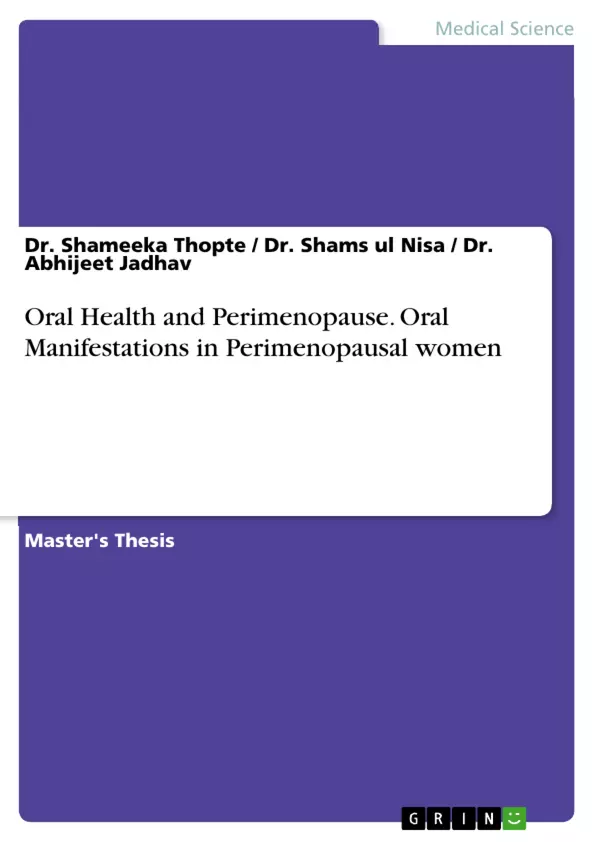There is a corelation between Menopause and the oral health of women. This study is based on the same.
The oral health status of women is becoming an increasing concern in health professions' education, research, and clinical practice. Oral health means much more than healthy teeth, and the relationship between oral and general health has been shown. The majority of pain and discomfort in the oral cavity is due to diseases of the mouth. However, there are situations where oral symptoms are a consequence of systemic diseases or systemic alterations in physiological conditions.
Oral discomfort is found in many menopausal women. The principal peri- and postmenopausal oral symptoms are a dry mouth, sensation of painful mouth of several causes, and less frequently burning mouth syndrome. Unpleasant symptoms connected to menopause are treated with hormone replacement therapy (HRT). HRT is widely used to relieve those symptoms in order to increase the well-being of the women treated. Profile studies on HRT users have indicated that these women are more health-conscious than non-users. Therefore, the hypothesis of the present study was based on the idea that women who had chosen to take HRT in the first place were those who also had better oral health and health habits in general.
Inhaltsverzeichnis (Table of Contents)
- INTRODUCTION
- DEFINITIONS
- Physiology of menopause
- Review of literature
- Oral health, menopause and hormone replacement therapy
- Oral symptoms and hormone therapy
- Periodontal health and menopause
- Periodontal health and hormone replacement therapy
- Salivary glands, saliva and menopause
- AIM
- OBJECTIVES
- METHODOLOGY
- Results
- References
Zielsetzung und Themenschwerpunkte (Objectives and Key Themes)
This dissertation aims to investigate the relationship between oral health and menopause, specifically focusing on the impact of hormone replacement therapy (HRT) on oral manifestations in perimenopausal women. The study seeks to determine the prevalence of oral health issues in this population and explore potential correlations between systemic symptoms of menopause and oral health changes.
- Oral health and menopause
- Hormone replacement therapy (HRT) and oral health
- Prevalence of oral manifestations in perimenopausal women
- Correlation between systemic symptoms and oral health changes
- Impact of menopause on oral health
Zusammenfassung der Kapitel (Chapter Summaries)
- INTRODUCTION: This chapter provides an overview of the importance of women's health and the significance of oral health in the context of menopause. It highlights the prevalence of oral health issues among perimenopausal women and the need for further research in this area.
- DEFINITIONS: This chapter defines key terms related to sex hormones, menopause, and oral health, providing a foundation for understanding the concepts discussed throughout the dissertation.
- Physiology of menopause: This chapter describes the physiological changes that occur during menopause, including hormonal fluctuations and their impact on various body systems. It lays the groundwork for understanding the potential implications of these changes on oral health.
- Review of literature: This chapter presents a comprehensive review of existing literature on the relationship between oral health, menopause, and HRT. It examines previous research on the prevalence of oral symptoms, the effects of HRT on oral health, and the role of dentists in managing oral health during menopause.
Schlüsselwörter (Keywords)
This dissertation focuses on the intersection of oral health and menopause, exploring the impact of hormone replacement therapy (HRT) on oral manifestations in perimenopausal women. Key themes include oral health status, menopause, hormone replacement therapy, prevalence of oral symptoms, correlation between systemic symptoms and oral health changes, and the role of dentists in managing oral health during menopause.
- Citation du texte
- Dr. Shameeka Thopte (Auteur), Dr. Shams ul Nisa (Auteur), Dr. Abhijeet Jadhav (Auteur), 2012, Oral Health and Perimenopause. Oral Manifestations in Perimenopausal women, Munich, GRIN Verlag, https://www.grin.com/document/335323



